Top 10 Patterns from the St. Johns
Adapting to conditions was key to landing spawning, staging fish
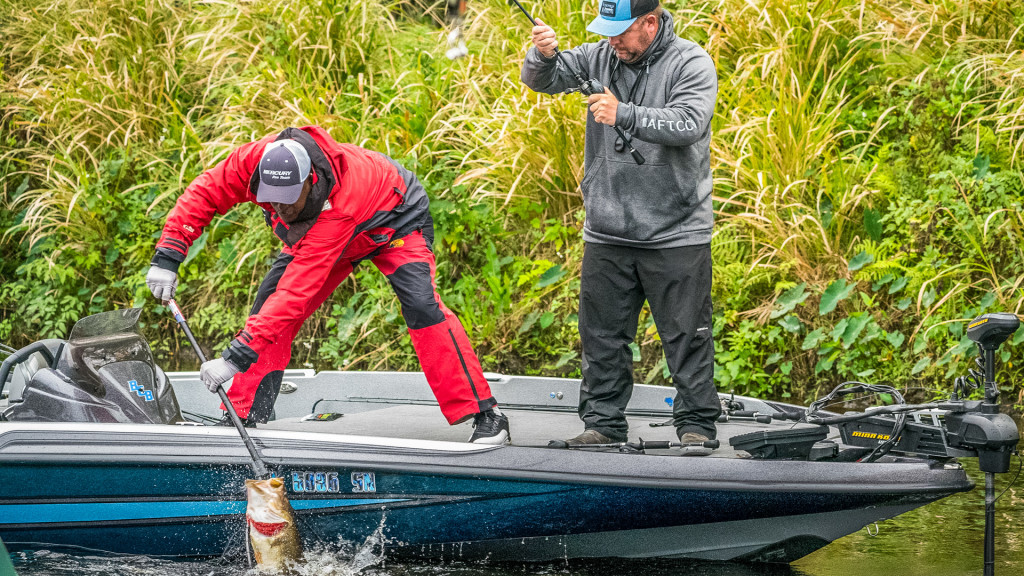
The Toyota Series Southern Division opener on the St. Johns River potentially missed some stellar fishing opportunities. Despite being the time of year when big green fish start to move up to the banks en masse to spawn, changing weather conditions and multiple cold fronts kept fish coming and going all week, opening small windows on which pros and co-anglers needed to capitalize.
On day one of the event, many expected fish that appeared to be on their way to the bank to spawn to actually be, well, on the banks. Instead, it was a constant ebb and flow of fish moving onto beds and disappearing by the next day.
Day two was terrific, but it brought with it rain, gusting winds and lower temperatures. By day three, many fish that were up shallow either moved back to staging points or weren’t too intent on eating anglers’ offerings.
Still, there were some big bags weighed in throughout the week, including nine 20-plus-pound stringers on day two (including one from co-angler Roger Hughes). Tournament winner Trevor Fitzgerald had his worst day on day two, but he was consistent enough the rest of the tournament to take the top spot by 6 pounds. Click here to read about his winning pattern.
Here’s how the rest of the top 10 caught their fish on the St. Johns.
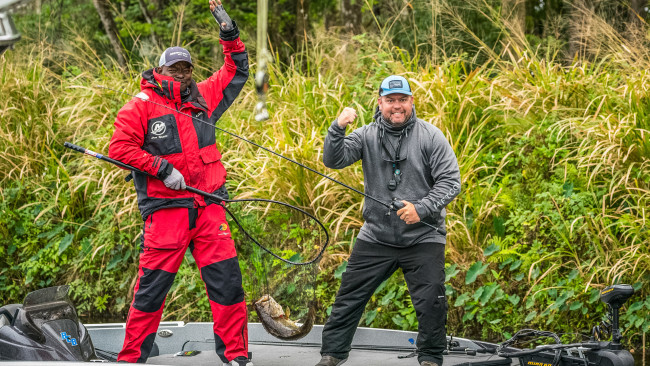
2. Blair sticks to the same six canals
Jason Blair sacked up 22-3 on day two to take over the lead from Fitzgerald, who led on day one and eventually took home the hardware. Blair kept it as simple as possible throughout the week to take second, and he kept it simple by simply sticking to one area.
“Every day for three days I fished the same six canals, and I feel like they got the cold last night [Friday] and moved out on me,” he says. “That was my pattern – fishing shallow, catching spawners – and I feel like the weather pushed them out.”
Those canals Blair fished had a lot of beds in them, which he was able to find during low tide in practice. As the weather continued a warming trend leading up to the event, he kept an eye out for fish moving to those beds, and it finally happened on day one.
“Day one they were in there, and day two they were in there,” he adds. “Today, I couldn’t get the big bite.”
To target those spawning fish, Blair keyed in on lily pads and made long casts along the edges, not necessarily sight-fishing so much as casting to where he knew there were beds.
He employed just one bait for the task: a Bruiser Baits Stick Worm (black blue tip), Texas-rigged with a 1/8-ounce tungsten weight. He threw that on a 7-foot, 3-inch, medium-heavy Fitzgerald Stunner rod and a Shimano Curado 7.4:1 reel spooled with Sunline 12-pound-test fluorocarbon.
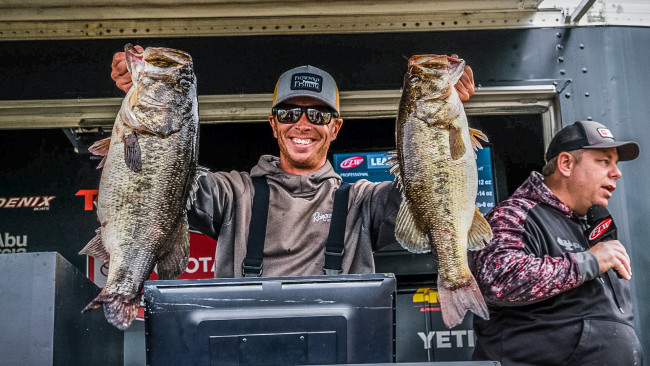
3. Hatala mixes it up
Steven Hatala brought 21-1 to the scale on Friday, and he pulled all that weight from lily pads and other cover in the Oklawaha River. That bag included a near-9-pounder, but he wouldn’t be done catching giant kickers.
“It was 1:45 [on day three], and we had 45 minutes to get back,” he recounts. “I flipped into a brush pile, caught a 4-pound buck, dropped it, flipped back and caught a 10-pounder on my last cast.”
It wasn’t quite 10 pounds, but Hatala wasn’t stretching the truth about that fish coming on his last cast. If he’d have landed the 4-pounder in addition to the giant, he’d have finished within just a few pounds of the lead in second place.
Still, it was a good week for the Michigan pro, who opted to explore some seawalls in canals near Lake George on day three. He was mostly sight-fishing with an added emphasis on his presentation.
“I was just throwing a Pocket Rocket on beds, and I was skipping it,” he says. “When I get a clean skip to the bed, they eat it before it even hits the bed.”
In addition to the Reaction Innovations Pocket Rocket (tramp stamp color), he also mixed in a black and blue Yamamoto Senko for similar techniques. To get those same fish fired up, Hatala also used a Lucky Craft Kelly J Prop Bait and a magnum walking bait.

4. Marks works slow around lily pads south of George
Rodney Marks does not like to fish slow. In fact, he despises it.
“You just have to fish slow, and I hate that,” he says. “I have a really good co-angler I travel with, and that’s his style of fishing. I always tell him that if we both get a bite, there’s something going on.
“You just have to slow down a little bit. If you catch them out on a shell bed or staging, you can throw some moving baits, but when they’re setting up trying to do something, you just rub the fuzz off everything.”
Still, that’s what worked for Marks in securing the fourth-place finish. Targeting a large stretch of sparse lily pads just south of Lake George, the Apopka, Fla., pro punctuated his week with 22-8 on day two, though he faltered a bit on the final day. He brought in a limit on Saturday, but he just never got a big bite.
While many pros targeted thick mats or lily pads, Marks preferred pads that were more spread out, both because he knew he’d still find fish there and because it was easier to work his bait of choice around them.
“You can catch them where it’s a little thicker,” he says. “I just like to work the bait in there. You don’t want the line hanging up over the pads. You could work it a little better in the sparse pads, and I think the fish kind of like it, too.”
To work around those pads, Marks employed a Zoom Ultra Vibe Speed Worm in a variety of colors (he says the fish were biting equally well on at least a few), including junebug, watermelon and some other natural colors. He Texas-rigged his Speed Worm on a 1/8-ounce weight with a straight-shank hook and threw it on a Level rod with a Shimano Chronarch MGL (7.1:1) reel spooled with 20-pound-test Sunline fluorocarbon.
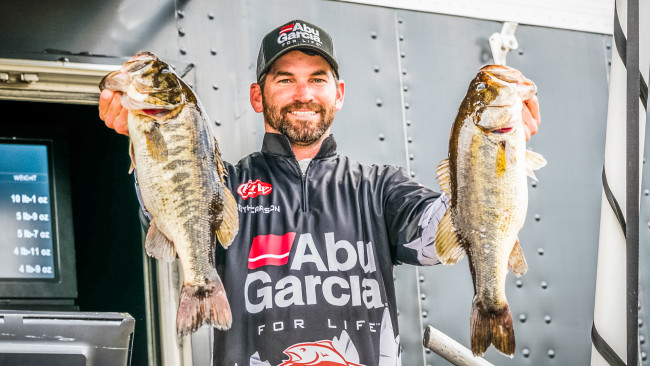
5. Carson runs a lot and then runs a little
Keith Carson only fished for about an hour on day two and still managed to weigh in 20 pounds, 5 ounces. He didn’t have boat trouble or any other troubles, for that matter. He just decided to run south until he found something he thought looked good, eventually stopping around Lake Monroe. After sacking up that big limit sight-fishing bedding bass, he made the three-hour run back to weigh-in.
That worked on day two, but Carson wasn’t as inclined to try to replicate that on Saturday. Instead, he went up the Oklawaha River to flip lily pads and target fish on beds.
“I felt like if I went and flipped all day, I could get some decent bites,” he says. “It just didn’t work out.”
What Carson didn’t account for was all the boat traffic in that area.
“It was something I didn’t calculate,” he adds. “I just made a mistake.”
Carson is specific about his bed-fishing baits and techniques. He used a Berkley PowerBait MaxScent Flatnose Jerk Shad in baby bass to target spawner. He threw it on a 7-foot, 3-inch, medium-heavy Abu Garcia Fantasista Premier rod and Abu Garcia Revo Premier reel in 7.3:1 gear ratio and spooled with 15-pound-test Berkley Trilene Big Game, letting the bait settle on slack line before giving it a quick pop. When blind flipping, Carson opted for a Berkley PowerBait Pit Boss (junebug) with a 1-ounce weight and a 7-foot, 6-inch, heavy Abu Garcia Veracity rod and the same reel, but with 50-pound-test Berkley X5 braid.

6. Gallelli makes long run north
Italy’s Jacopo Gallelli went against the grain this week, running north while most of the field headed south from takeoff. He ended up on Doctors Lake, near Jacksonville, where he was targeting both staging and spawning fish.
“I was fishing transition fish from staging to spawning in this creek on a little lake,” he says. “I found them in practice, like, seven days ago, and then I left them.”
When he eventually returned, Gallelli was pleased to find many of those fish still pushing shallow, and he ran a dock pattern to do most of his damage. Gallelli also targeted isolated wood and lily pads where he knew he’d find some fish on beds.
Unfortunately, the tale of the tournament for Gallelli was lost fish.
“Yesterday [Friday], I lost a 5 and a 4, and even today I lost a couple big ones,” he explains. “The fish today were biting very bad.”
Fishing around docks, Gallelli relied on a vibrating jig with a Lake Fork Magic Shad trailer in green pumpkin to do most of his damage. He also used a Neko rig and a Zoom Ultra Vibe Speed Worm as follow-up baits for when he missed bites on the vibrating jig.

7. Kelley capitalizes on nasty weather
Jonathan Kelley likes the rain, at least on the St. Johns, anyway.
“I knew with the conditions coming day two you had to go prespawn and wherever they were going to stage,” he says. “From past experience on the St. Johns, I’ve caught them really well when we have foul conditions. I knew yesterday [day two] was going to be the day I could really smash them.”
And smash them he did, to the tune of 22-5.
Things went south on day three, though, and that staging bank proved to no longer be the juice for Kelley.
“[Saturday], I started out on the prespawn staging bank hoping the little bit of cold front last night would help, but I know when it gets full-sun, no-clouds here it’s bad. It gets real tough. Right away I lost three fish real quick.”
When that pattern had all but dried up, Kelley ran south to some lily pads and eventually into some canals, which led to two fish for 4-12 on the day. Because the tide never really dropped – the water level actually increased on day three – Kelley wasn’t able to sight-fish anything in those canals.
For fishing around wood and isolated cover, Kelley opted for an X Zone True Center Stick (black and blue) with a 1/8-ounce Eco Pro Tungsten weight, Texas-rigged on 15-pound-test P-Line Tactical Fluorocarbon and a 7-foot, medium-heavy Denali worm and jig rod and a Shimano Chronarch MGL (7.1:1) reel. For heavier flipping, Kelley went with a Berkley Pit Boss (black and blue) with a 1/2-ounce Eco Pro Tungsten weight on 65-pound-test PowerPro braid and a 7-foot, 8-inch Denali N3 rod and the same Shimano Chronarch reel.

8. Kitchens sticks to Dexter
For three days, Frank Kitchens III made the run down south to Lake Dexter to take advantage of some cleaner water while flipping large fields of lily pads.
“I think the water was real clear, close to the river channel and real shallow,” he says of his stomping grounds. “It was just a good spot.”
It was definitely a good spot for the first two days, producing 36 pounds, 12 ounces between Thursday and Friday. On Saturday, the conditions were just too much to allow that spot to hold up.
“I stayed in that exact spot, and I think the wind blew so hard it blew it out and just muddied it up,” he adds. “They just weren’t biting.”
While it didn’t quite work out on day three, Kitchens definitely had a solid area to fish. There wasn’t as much pressure down that far, and he says the fish were moving up shallow faster than he could catch them.
One bait got the job done for Kitchens this week: a white 3/8-ounce Z-Man/Evergreen ChatterBait Jack Hammer with a Strike King Rage Tail Craw trailer, fished with a Lew’s Speed Spool reel and Stren 20-pound-test monofilament line.
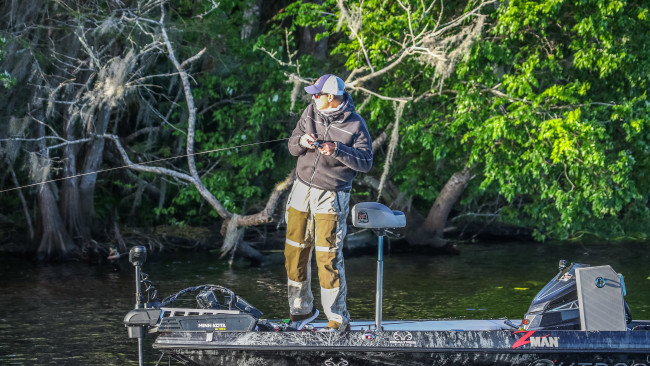
9. Meninger targets pads down south
Like a good portion of the field, Jason Meninger opted to run down south this week to a large stretch of river littered with lily pads just below Lake George. He also made a foray into Lake Dexter for a bit, but decided to stick with the original area on day three.
“I thought I was going to go down there today [Saturday] and just wreck them, and literally by 11 o’clock I think I had three or four bites and only landed one,” he says of his tough day three that resulted in just two fish for 3-2.
“I was really surprised. I thought for as many fish I lost and bites I had the last two days, I thought I could at least catch a limit down there.”
As Meninger’s pattern fizzled, he picked up and ran some canals to catch one of his two fish for the day.
The Saint Augustine, Fla., pro wasn’t too particular about the pads he was fishing, targeting spawning and staging fish in both sparse and thicker stretches of pads. The key for Meninger was working the outsides of those pad fields with different setups.
For sparse cover, Meninger used a black and blue Z-Man ZinkerZ Texas-rigged with a 1/8- or 3/16-ounce weight on a 7-foot, 6-inch, heavy Halo rod and a Shimano Metanium 8.5:1 reel spooled with 18-pound-test Sunline fluorocarbon. For the thicker stuff, Meninger employed the same bait but with a 1/2- or 3/4-ounce weight with 45-pound-test PowerPro Maxcuatro braid spooled on the same Shimano reel and paired with a 7-foot, 9-inch, heavy Halo Kryptonite flipping stick.

10. Hensley targets docks
While several fellow top 10 anglers were targeting lily pads or docks, Chris Hensley was looking for areas that had both.
“Most of my fish came off of docks that had pads around them,” he says. “Unless they were just isolated off by themselves; you could catch one or two off of those.”
Hensley wasn’t sight-fishing, but that’s not from a lack of trying. The water was just too dirty in the area he was fishing, and rising water levels on day three didn’t help matters.
“I know my water was dirtier today [Saturday],” Hensley adds. “Yesterday, you could see probably 18 inches to 2 foot maybe. Today, you probably couldn’t see 10 inches.”
Even so, Hensley was confident the clear, sunny skies would push his fish up and position them under the docks he was targeting. Instead, he got three bites all day and didn’t land a fish.
“They were just barely picking it up,” he says. “They weren’t hitting it like they were yesterday. I probably had 20 or 25 bites yesterday. I never hooked a fish today.”
Hensley was definitely around the right fish, though, as evidenced by his tournament-best 24-pound, 4-ounce bag on day two.
To catch his fish, Hensley wacky-rigged a Bass Pro Shops Stik-O (junebug) or fished it on a Texas rig with a 3/16-ounce tungsten weight around heavier cover. He used a 7-foot Kistler Magnesium 2 spinning rod for the wacky rig (with a Bass Pro Shops Johnny Morris Signature Series spinning reel) and a 7-foot, medium-heavy Kistler Magnesium 2 casting rod with a Bass Pro Shops Johnny Morris Signature Series casting reel (7.5:1) for the heavier setup.